A unique safari through the Brazilian Pantanal
(Image credit:
Natphotos/Getty Images
)
Extraordinary wildlife, cattle farming and horseback riding are an integral part of life in the Pantanal – and a horse safari allows you to see this up close.
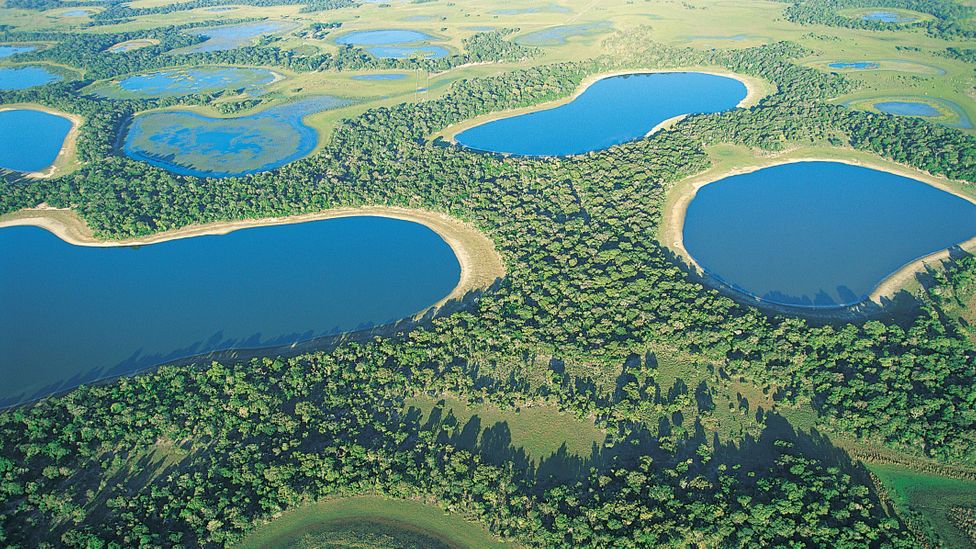
T
The carcass was a grisly sight. The remains of the yacare caiman, a South American relative of the alligator, were largely intact bar a fatal gash to its nape, the tell-tale signs of a jaguar attack. It meant the world's third-biggest cat had been there the night before, and I was about to go looking for it.
I was in the north of the Brazilian Pantanal, the largest wetland on the planet, home to a rich variety of animal and plant species. Stretching more than 140,000 sq km across Brazil, Bolivia and Paraguay, the annual cycle of rainy and dry seasons governs the land, creating a dynamic mosaic of wetlands, grasslands and forests.
Tens of thousands of tourists flock to the Pantanal each year to fish, spot some of the wetland's 500 bird species and see Brazil's "big five": the giant anteater, the giant otter, the tapir, the maned wolf and the jaguar – the biome's main star. Most visitors join groups on river cruises or in 4X4s for wildlife watching, especially in Porto Jofre, a place renowned for its jaguar sightings.
This time though, I'd swapped the rumbling vehicles for the slow-paced experience of horse riding in a lesser-explored area near a town called Poconé, 146km north of Porto Jofre. One thing was for sure, if there was a big cat nearby, my horse would sense it. "They're pretty scared of [them], so you would know if there was a jaguar around," said Abigail Martin, founder of the Jaguar Identification Project, a non-profit that catalogues jaguars in the Pantanal. "A horse is going to act very strange."
Jaguars are one of Brazil's "big five", along with the giant anteater, giant otter, tapir and maned wolf (Credit: Gerald Corsi/Getty Images)
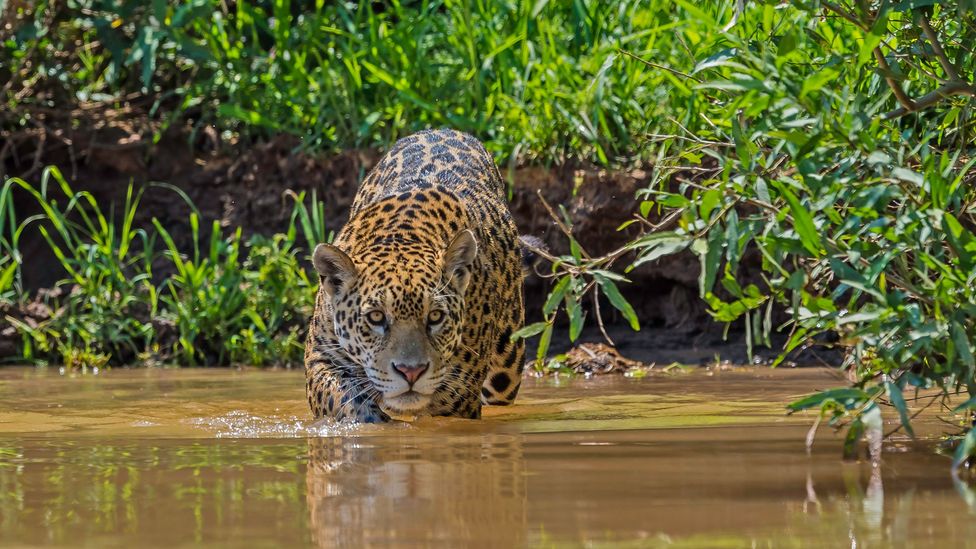
Having mounted my steed, a docile bay mare called Dourada (meaning "Golden"), I shifted into a comfortable position on the padded saddle and loosely held the reins. My guide, Erivelto Oliveira, who leads horse safaris at the Pousada Piuval eco-lodge, swung up onto his grey Pantaneiro horse and led the way towards the swampy grassland dotted with gnarled trees.
Each horse safari is different, said Oliveira. "Sometimes you go out at 08:00 in the morning and don't see many things. Then you go out at 10:30 and see jaguars, tapirs," he said. "You never know what's there."
Most lodges throughout the Pantanal offer horseback safaris that vary from a couple of hours to overnight expeditions complete with sleeping outdoors. The one with Pousada Piuval typically takes 1.5 hours.
The best time of year to visit is from May through December. During the rainy season, many lodges close.
Being in one of the most biodiverse places in the world guarantees wildlife sightings nevertheless. Sure enough, Oliveira immediately started identifying birds, swiftly reeling out their names: "there's the ringed kingfisher" and "that's the roseate spoonbill". He drew my attention to the top of a tree where six dazzling cobalt-blue hyacinth macaws were perched. Without a boat's sputter or a truck's rattle in the background, a horseback safari is a treat for the senses – the sticky smell of humidity mingled with the incessant din of whoops, whistles, clicks and cackles over the cicadas' steady hum. We traversed muddy trails trodden down by cattle and imprinted with the giant three-toed footprints of rheas, the South American equivalent to emus.
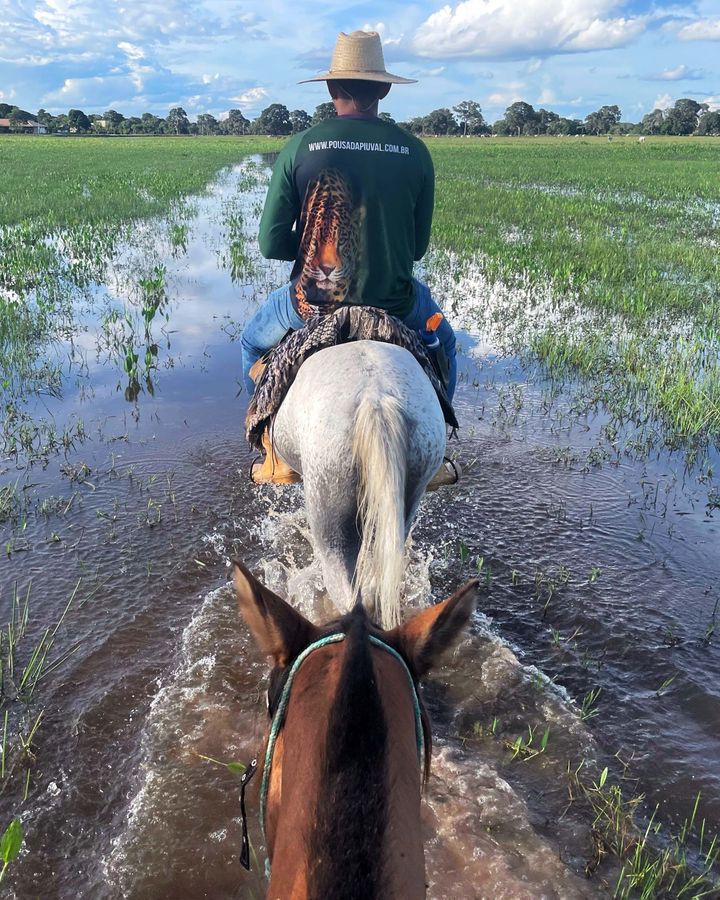
Approximately 90% of the Pantanal is owned by cattle ranchers, dividing most of the wetlands into largely unfenced, extensive farms. The sweeping pastures maintain most of the natural vegetation, where herds of white cattle with thick neck humps roam freely among the Pantanal's wildlife, like the wildebeests in the Serengeti. Horses also rove these vast expanses, sharing the same habitat as the jaguar. However, attacks on horses are rare, especially when humans are nearby. South America's largest big cat typically favours caimans, peccaries (small pig-like animals) or cows and their calves, much to the ranchers' exasperation.
Horse safaris are an excellent way to explore the wetlands of the Pantanal (Credit: Sarah Brown)
On horseback, we meandered through these herds, prompting dusky-legged guans to frantically run between bovines as we approached. Over to our left was a swamp, a caiman haven. Oliveira veered towards it and Dourada dutifully followed, her body calm but ears pricked up on alert.
The Pantaneiro horses are perfectly adapted to the wetlands' harsh conditions. Descendants of Iberian horses first introduced to the region in the 16th Century by Spanish settlers, they evolved the ability to graze with their noses underwater and developed thick hooves able to withstand long periods submerged. "Any other breed wouldn't be able to stand it because the water rots the hoof. It's like leaving your nails in water," said Junior Losano, a Pantaneiro horse breeder at the Pousada Piuval.
The Pantaneiro horse is essential for the Pantaneiros (Pantanal ranchers) and their livelihoods. "Without the Pantaneiro horse, there would be no livestock," said Sandra Santos, a researcher at Embrapa, the Brazilian agricultural institute. Famed for their resilience and endurance, the Pantaneiro horse is used to manage cattle in areas off-limits for vehicles, especially water-logged land covered in swathes of vegetation. It's also an important companion and means of getting around.
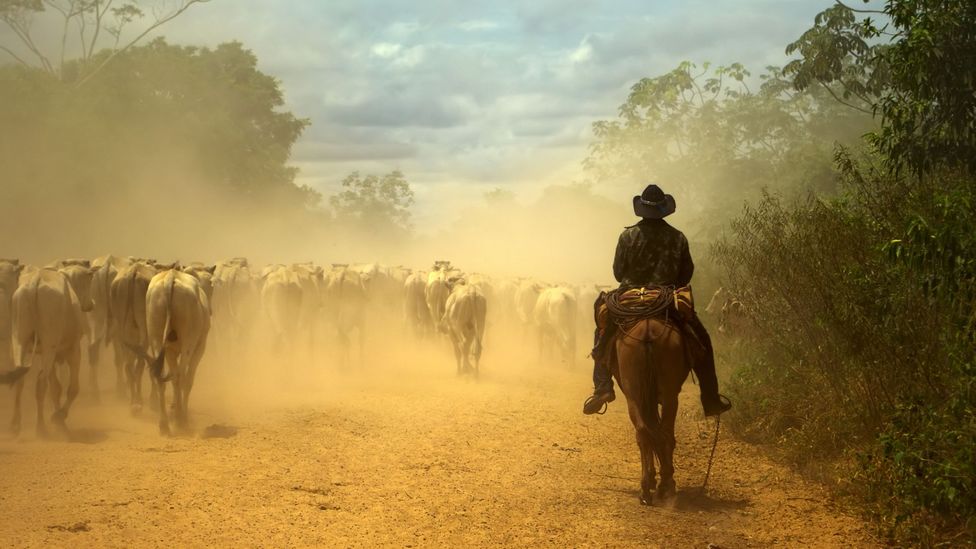
"[When] the Pantaneiros started coming to the Pantanal, the horse became a form of transport and a friend," Losano said. "There's no way you can get through the Pantanal without a horse, in a place where everything is flooded."
Approximately 90% of the Pantanal is owned by cattle ranchers (Credit: JohannesCompaan/Getty Images)
Nowadays, they're also used in tourism, ranch riding competitions and even equine therapy, Losano added. "It's a very calm horse," he said. Riding Dourada across the Pantanal was like taking a step back in time, following the same paths ranchers have trekked for the last three centuries.
We approached the wetlands, the murky swamp swirling around our horses' hocks. There were no signs of a jaguar yet, but over in the distance I spotted a group of capybaras grazing near several caimans basking in the hot sun. Yacare caimans are typically wary of humans and tend to retreat when approached. The main human-animal conflicts in the Pantanal are between jaguars and ranchers who sometimes kill the big cats in retaliation for cattle losses. It's a complex relationship that conservationists are trying to navigate.
As an apex predator, jaguars keep prey populations, such as caimans and capybaras, under control, helping to maintain a healthy ecosystem. They also bring money to the region. A 2017 study found that jaguar ecotourism generates more than US$6.8m (£5.4m) per year – and experts, such as Martin, suspect that's doubled in recent years. However, cattle ranchers, the ones whose livelihoods are affected by jaguars, "don't get a single bit of it", Martin said. The goal is to find a way to involve ranchers, such as charging a "jaguar tax" to tourists who enter private land to see the big cats that is then paid back to landowners to compensate for cattle lost to jaguars. It gives ranchers a reason to protect them and seeks to change their perception of jaguars as pests.
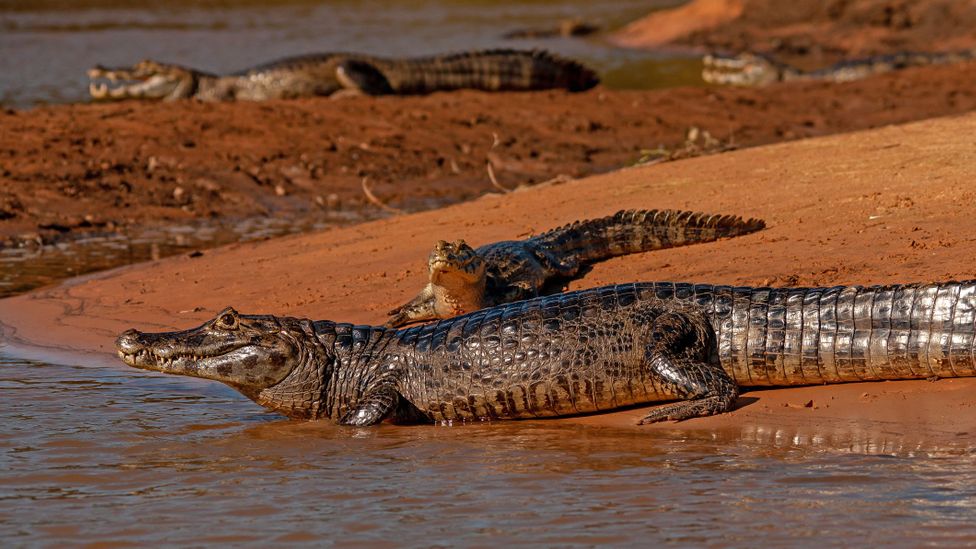
Large populations of yacare caimans can be found within the Brazilian Pantanal (Credit: Ibrahim Suha Derbent/Getty Images)
We continued through the water, which now soaked the underbellies of our horses. Bubbles rose from the depths and popped on the surface, possibly from a crab or perhaps a hidden caiman. It was March, the end of the rainy season, which begins in November and floods up to 80% of the Pantanal, rendering many parts inaccessible. The rest of the year is the dry season. During this period, dozens of birds and animal species cluster around the few remaining waterholes, making them much easier to see.
As the sun began to set, we wandered back. The buzz of the cicadas had turned up a notch and, in the distance, fireflies sparked between trees. While I hadn't seen a jaguar this time, there was still something special about experiencing the nuances of the wetlands on horseback rather than having a metal barrier between the wildlife and the observer. Martin had told me, "There's something called the Pantanal Fever for biologists. Once you go, you have to go back." I felt the same fever applied even for passing visitors like me.
I spotted two Pantaneiros on horseback, their wide-brimmed leather hats shielding their eyes against the lowering sun, their faces catching its orange glow. They trotted off into the horizon back to their ranches, just as their ancestors have done for generations. For a moment, I had experienced a slice of their world, before my horse turned the other way behind my guide and we headed back.
---
Join more than three million BBC Travel fans by liking us on Facebook, or follow us on Twitter and Instagram.
If you liked this story, sign up for the weekly bbc.com features newsletter called "The Essential List". A handpicked selection of stories from BBC Future, Culture, Worklife and Travel, delivered to your inbox every Friday.









































